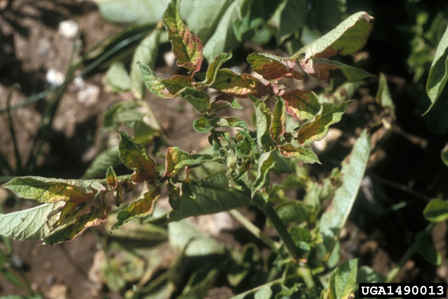Candidatus Liberibacter solanacearum
Candidatus Liberibacter solanacearum (or CLso) is a bacterial plant pathogen that is exotic to Australia. It causes serious economic damage in solanaceous crops such as potato, tomato, capsicum and eggplant. CLso is one of Australia’s national priority plant pests and there are strict quarantine measures in place to prevent its introduction into Australia.
CLso is known to occur in North and Central America, Ecuador, New Zealand, Europe and parts of northern Africa.
Seven haplotypes (variants) of CLso have been described:
- Haploytpes A, B and F are associated with solanaceous crops (e.g. potato and tomato)
- Haploytpes C, D and E are associated with apiaceous crops (e.g. carrot and celery)
- Haplotype U is associated with stinging nettle
Transmission
CLso is spread (vectored) by psyllids. Known psyllid vectors are Bactericera cockerelli (which is also known as the tomato potato psyllid or TPP), Trioza apicalis and Bactericera trigonica.
CLso is also spread through planting or grafting from CLso-infected materials (e.g. seed or tissue culture).
Host range
CLso infects solanaceous plants such as potato, tomato, and capsicum, as well as solanaceous weeds such as Datura stramonium (jimsonweed) and Solanum elaeagnifolium (silverleaf nightshade). It also infects apiaceous crops such as carrot and celery.
A short list of common agricultural crop, garden vegetable and weed hosts are listed in the table below. For more extensive host information, please check the European and Mediterranean Plant Protection Organization and Centre for Agriculture and Biosciences International host lists.
Common agricultural crop, garden vegetable and weed hosts of CLso
Family | Species |
|---|---|
Solanaceae | Solanum tuberosum (potato), Solanum lycopersicum (tomato), Capsicum annuum (pepper), Solanum betaceum (tamarillo), Nicotiana tabacum (tobacco), Solanum melongena (eggplant), Physalis peruviana (tomatillo), Solanum elaeagnifolium (silverleaf nightshade), Solanum ptychanthum (black nightshade), and other crops or weeds in the family Solanaceae |
Apiaceae | Daucus carota (carrot), Apium graveolens (celery), Pastinaca sativa (parsnip), Petroselinum crispum (parsley), Anthriscus cerefolium (chervil) and Foeniculum vulgare (fennel) and other crops or weeds in the family Apiaceae |
Other | Urtica dioica (stinging nettle) |
Symptoms of CLso
Symptoms of CLso infection differ between hosts.
In potato (see the photo below), symptoms include chlorosis, wilting, purpling of leaves, leaf scorching, twisted stems (zigzag appearance), proliferation of axillary buds, shortened internodes, swollen nodes, aerial tubers and vascular discolouration is observed in plants. Symptoms in tubers include small and misshapen tubers with rough skin, browning of vascular tissue, collapsed stolons and dark stripes throughout the entire length of the tuber. CLso infection of potato is commonly known as zebra chip because of the dark stripes it causes in tubers.
In tomato, symptoms include spiky, chlorotic apical growth, leaf mottling, curling of the midveins, stunted plants and fruit deformation (cultivar dependent) is observed in plants. CLso infection in tomato is known as psyllid yellows.
In carrot, symptoms include leaf curling, discoloration of leaves (yellow, bronze or purple), stunting of the carrot shoots and roots, and proliferation of secondary roots. CLso infection in carrot is known as yellow decline.
Symptoms in celery include growth of an abnormal number of shoots, curling of stems and yellowing.

For more photos of CLso symptoms in different host plants, please check the photo sections of the European and Mediterranean Plant Protection Organization and Centre for Agriculture and Biosciences International web pages.
Detection and prevention measures
There is currently no cure available for CLso. Because of this, early detection and public reporting is critical. Agriculture Victoria regularly responds to reports of suspect plant diseases and conducts exclusion diagnostics on plants with symptoms of exotic diseases
To protect your property, maintain best practice on-farm biosecurity standards, ensure seed and other propagation material is purchased from reputable suppliers and regularly check your plants for symptoms. If you spot any unusual symptoms or suspect CLso is present on your property, please submit a report online using the online reporting form below.
Reporting an unusual plant insect pest or disease
Report any unusual plant pest or disease immediately using our online reporting form or by calling the Exotic Plant Pest Hotline on 1800 084 881. Early reporting increases the chance of effective control and eradication.
Please take multiple good quality photos of the pests or damage to include in your report where possible, as this is essential for rapid pest and disease diagnosis and response.
Your report will be responded to by an experienced staff member, who may seek more information about the detection and explain next steps.
Report online